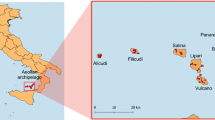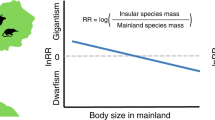Abstract
In biology, spandrels are phenotypic traits that evolve through their underlying developmental, genetic, and/or structural links to another trait under selection^1, 2, 3^. Despite the importance of the concept of spandrels in biology, empirical examples of spandrels are exceedingly rare at the organismal level^2, 3^. Here we test whether body size evolution in insular populations of a snake (Elaphe quadrivirgata) is the result of an adaptive response to differences in available prey, or the result of a non-adaptive spandrel resulting from selection on gape size. In contrast to previous hypotheses, Mantel tests show that body size does not coevolve with diet. However, gape size tightly matches diet (birds vs. lizards) across populations, even after controlling for the effects of body size, genetic, and geographic distance. Moreover, gape and body size show a strong degree of phenotypic covariation. Thus, the dramatic insular body size variation among E. quadrivirgata populations is at least partially caused by its underlying phenotypic covariation with gape size rather than the result of direct selection on overall body size.
Similar content being viewed by others
Article PDF
Author information
Authors and Affiliations
Corresponding author
Rights and permissions
About this article
Cite this article
Vincent, S., Brandley, M., Kuriyama, T. et al. Insular gigantism and dwarfism in a snake, adaptive response or spandrel to selection on gape size?. Nat Prec (2009). https://doi.org/10.1038/npre.2009.3360.1
Received:
Accepted:
Published:
DOI: https://doi.org/10.1038/npre.2009.3360.1



